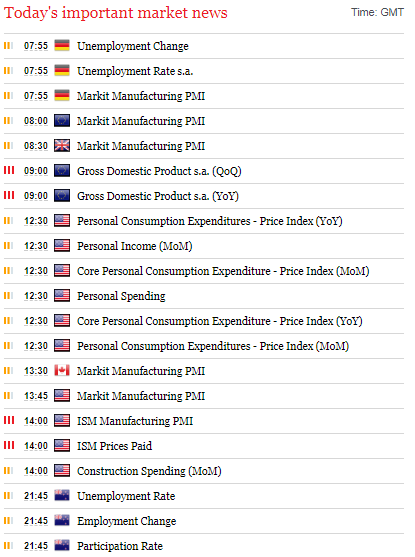Earlier this morning, the Reserve Bank of Australia kept its official cash rate on hold, at 1.5%, as the market had expected. Australia’s headline inflation for the year to date of 1.9% is below the RBA’s target band of 2 to 3%, so any hike in interest rates was always unlikely. More so, export demand may be reduced with recent USD weakening and strengthening commodity prices putting pressure on AUD.
In another showing of the Trump Administrations lack of “continuity” the recently positioned Chief of Staff, John Kelly, fired Trumps recently installed communications director Anthony Scaramucci after just 10 days in the job. Concern abounds from the markets that the US Administration is in turmoil, although Kelly’s appointment may bring ease to the markets as he is regarded as a tough disciplinarian. USD weakness continued Monday with key levels being breached in many financial instruments. There appears to be no immediate respite to USD pressure, although Friday’s NFP may slow further USD declines?
EURUSD rose on Monday to 1.1846; levels not seen since January of 2015. EURUSD has gained nearly 15% since trading around 1.0340 back in early January. Markets are eyeing 1.20 as the next major level if USD weakness continues. EURUSD is currently trading around 1.1820.
USDJPY fell to a 6-week low on Monday of 110.005 and is little changed overnight, currently trading around 110.25.
GBP remains strong against USD and is currently trading just above 1.3200, after hitting an early high on Tuesday of 1.32344.
AUDUSD improved on Monday on the back of improved Chinese data and is little changed following the RBA announcement that kept the official cash rate at 1.5%. Currently, AUDUSD is trading around 0.8010.
Gold remains strong, reaching levels not seen since late 2016. Gold is currently trading around $1,269.5.
Oil maintained its recent gains and may move higher, as the US announced that it was imposing sanctions against Venezuelan President Maduro. Currently, WTI is trading near Tuesday’s high of $50.35pb.
At 10:00 BST Eurostat will release Eurozone Gross Domestic Product (YoY) & (QoQ) for the second quarter. Year on Year consensus is expected at 2.1%, an improvement on Q1’s release of 1.9%. Markets will be looking to see that the Eurozone economy is indeed strengthening, which should mean an easing of monetary policy by the ECB.
At 13:30 BST will see a plethora of data releases from the US: Personal Consumption expenditures. Personal Income & Personal Spending all (MoM) and (YoY). The markets need to see an improvement in all the releases to underline an improving US economy. Spending needs to improve to get an upward move in CPI that will help the Federal Reserve justify any further hikes by year end.
AT 15:00 BST the Institute for Supply Management (ISM) will release Manufacturing PMI (Jul) and Prices Paid. Consensus for both releases are 56.5 and 56 respectively (from 57.8 and 55 respectively previously). As an indicator of Business conditions in the US Manufacturing sector, a slight reduction is expected but a significant drop will see further downward pressure on USD.

Source: DirecFX Forex Broker
Categories :
Tags : Eurozone Gross Domestic Product Manufacturing PMI Reserve Bank of Australia






